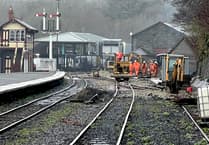An accident investigation into a tram derailment has finally been released after a review.
The investigation concludes that speed was not a factor in the July 2021 accident – but highlights shortcomings in the maintenance regime at the Manx Electric Railway.
A passenger broke their leg after tram no.16, driven by the then public transport director Ian Longworth, came off the rails near Lewaigue.
The Department of Infrastructure initially refused to release the report in response to a Freedom of Information request submitted by the Examiner, citing an exemption that legal proceedings were ongoing.
But we sought a review of that decision, pointing out that the court case had concluded earlier this year with the DoI fined £18,000 for health and safety failings relating to inadequate maintenance procedures.
The department has now apologised for wrongly applying the exemption.
‘Toast-rack’ tramcar no.16 was carrying 12 passengers, two of them seated on the driver’s bench, on a scheduled service when it derailed between Dreemskerry Farm and Lewaigue at 6.40pm on July 16, 2021.
It came to a halt on a ballast shoulder.
A passenger who had been seated on the landside of the driver’s bench was ejected from the tramcar during the derailment and suffered a broken leg and bruising.
All other passengers and staff were unharmed but shocked.
The driver, whose name is redacted in the published report, is described as an experienced motorman with more than 40 years’ experience of driving tramcars.
He stated that on applying the brakes at the start of the descent to Lewaigue the brake action became rough followed by no brake and a bumpy ride until the car finally left the track.
Data showed the tramcar was travelling at 21mph when it derailed and had consistently been driven at below the 25mph maximum speed limit.
A number of passengers maintained that speed may have been a causal or contributory factor to the accident.
But the investigation found that the open environment of a ‘toast-rack’ tramcar gave a much higher perception of speed.
‘I do not consider speed to have been a contributory factor nor did it enhance the consequences of the derailment,’ the inspector states.
The investigation found the tyres were all worn well below any recognised limits and there was a clear brittle fracture in the leading axle, left hand side tyre.
Only two of the tyres on the car ‘rang’ when struck with a hammer. Hammer testing is a well-established principle used to detect tyres that are cracked or no longer ductile.
The investigation found that the tyres and axles had not been inspected prior to operation nor had they been hammer tested.
If they had of been it is ‘highly probable’ that the faulty tyres would have been detected, notes the report.
It also found that depot maintenance staff had no access to wheelset standards or measuring equipment.
There were no vehicle maintenance instructions for the maintenance staff to follow.
And there was no professional engineering oversight of the condition and maintenance of the cars.
Following the accident, all tramcars and trailers with composite tyred wheels were withdrawn from service pending an engineering assessment.
The accident investigator had recommended in 2019 that vehicle maintenance instructions be produced for all the heritage railways ‘to ensure ad hoc maintenance is a thing of the past’.
This recommendation followed the inquiry by the Health and Safety at Work Inspectorate into the potentially catastrophic 2017 runaway tram incident on the Snaefell Mountain Railway.
The accident investigation report into Lewaigue derailment contains a series of recommendations.
It says maintenance and safety limits for wheelsets used on the MER must be defined and steel gauges for measuring tramcar wheel profiles procured, with staff thoroughly trained on wheelset inspection.
Results of these inspections should be recorded in suitable detail on the annual and periodic inspection record sheets as well as each tram’s daily fitness to run sheet.
The report recommends a competent engineer is assigned to Derby Castle car sheds to review the condition of the trams and trailers, continue to produce suitable vehicle maintenance instructions that include maintenance and safety limits, mentor and train the maintenance team and take responsibility for the safety of the rolling stock.
An engineer should also be available on an on-call basis to provide advice to motormen should a tramcar fail in service, the report suggests.
It says all vehicles on all the railways that have composite tyred wheels should with immediate effect be subject to a daily wheel tap.
A survey of locations where a derailment
could result in a potential steep drop, should be carried out within three months to ensure there is a suitable restraining ballast shoulder, the report recommends.
And it says consideration should be given to fitting of speedometers and forward-facing cameras to the tramcars.




